Mites (Akari)
The microorganism we have examined so far represent a whole wide world existing in huge numbers inside, outside and all around us, in short everywhere we are. Yet there is another living thing that is also part of this world and, like the others, also shares every environment with us. These living things, known as Mites, are tiny microorganisms with features no different to those of any insect in complexity that possess an exceptionally detailed and complex structure, and are just 5 to -50 microns in size, visible only under the microscope. They live everywhere, in every corner of your home, in the bed you sleep in, the carpets on the floor, the air you breathe, wherever you spend your life. These entities, resembling tiny fat spiders, cover every square centimeter of our environment.
 |
Mites can be found everywhere, all over the house, in the bed you sleep in, in the carpet on the floor, in the air you breathe, in short everywhere you spend your life. The fact that these creatures are invisible is an example of the wisdom in Allah's Creation. |
These arachnids feed on dead skin cells, which is why they are found wherever humans are present and are spread about by means of human activity, to where their feeding materials collect—generally beds and pillows, furniture and carpets.
No doubt the fact that human beings cannot see them under normal conditions, is an example of Allah's wise Creation. They are present in such great numbers that even in your bed, no matter how clean it may be, there will be an average of 10,000 of them. Yet they do not bite, or sting or spread diseases. They do no harm, so long as you are not allergic to the proteins they produce.
However, they do, harm some other species. In fact, they can wipe out a bee colony in which they live as parasites, by piercing a bee's exoskeleton and sucking out their bodily fluids. They are able to injure many insects, animals and plants in the same way; yet still others provide various benefits. For example, mites cause insect pests to die or fall ill, and the waste products they produce also increase soil fertility. Some parasitize many animals species, living in their ear canals, lungs and intestines.
According to species, mites can be found in differing locations—5,000 meters (16,400 feet) up on the slopes of Mt. Everest, or in depths of 5,200 meters (17,060 feet) down in the Pacific Ocean. More than 50 species of mite are known to live in the Antarctic alone. They can also be found in caves, deserts and tundra, in mines 10 meters (32.8 feet) deep, in the cold or in thermal springs with temperatures as high as 500C, in underground waters, lakes and pools. It has been estimated that there are more than 500,000 of these different species living in different habitats.100
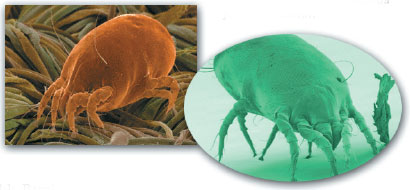 |
Mites living in homes, particularly carpets. |
During their life cycles, mites go through four stages; egg, larva, nymph and adult. This period between egg and adulthood lasts for about one month. The female egg-laying population increases by up to 25-30 times a week. Adult mites molt once and can live for up to two months, depending on environmental moisture levels and temperature.
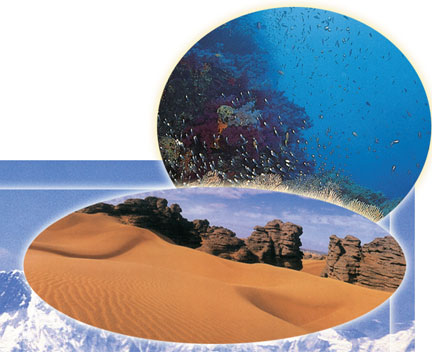 |
In the same way that mites can survive on the high peaks of Mount Everest, they can also be found in the depths of the seas. |
Mites do not drink water, but absorb moisture from the air and their environment. Therefore, they prefer quite high levels of humidity, 70 to 80%, and temperatures around 270C. 101 When they find such a suitable environment, they can increase their numbers enormously. For example, there may be up to 6 million members in half a hectare of cultivated soil. 102
 |
We subjected the mountains to glorify with him in the evening and at sunrise. (Surah Sâd, 18) |
Mites Have Very Complex Bodily Structures
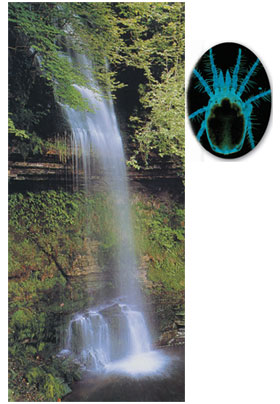 |
Mites can survive in underground waters, pools and lakes at temperatures of up to 500C degrees. |
What kind of body does this invertebrate, living in a world we cannot see and that can be examined only under the microscope, possess? Does their body consist of a single cell? Or do they consist of several cells combined and a few organelles? Since they are so minute, they should have few details, features or organs. Under normal conditions these living things have no visible specific volume, and it would appear impossible for them to have complex features. So let us see: Is the mite body any different to that of other microorganisms?
Mites have oval exoskeletons covered with sparse hairs on them. The mouth at the front of this hard body has a special structure for piercing. Thanks to this special structure, the mite can tear into small pieces and consume the food it finds. Eight legs protrude from this oval body, and their feet are covered in a very important Creation—a sticky substance that lets the mite bury itself among carpet threads and deep folds in the skin. These eight legs are able to withstand even the most powerful vacuum cleaners.
This is just the external appearance of these microscopic creatures. The body of this creature, which is invisible to the naked eye but which lives alongside us at every moment, also has an inside. This mite, the existence of which we were perhaps unaware of until now, possesses quite wide-ranging internal organs:
Some mites can live in water as well as on land, but those that live on land breathe through a respiratory tube,103 immediately next to which is their feeding tube. Some mites have feeding apparatus sharp enough to pierce plant cells, with which they can easily suck up juices from the plant.104 In some mites, a rather advanced nervous system surrounds the feeding tube. The microscopic invisible mite even has a brain. A series of nerves emanating from the brain operate the legs, muscles and the reproductive system. The nerves in the mouth organ are controlled by another part of the brain.
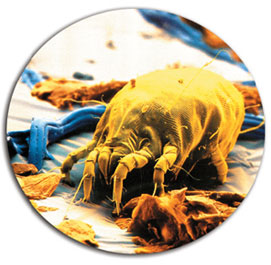 |
Mites, which we can only observe under the microscope, possess wide-ranging bodily structures. The details comprising the organisms reveal the complex Creation on Earth. |
Of course, the mite must have a digestive system to obtain nourishment from what it eats. This consists of a pharynx at the front, a long, narrow esophagus, a stomach, a short intestine and an intestinal cavity at the back. The stomach has double sacs or ventricles that serve partly as food storage organs, and allow some mites to survive for long periods without eating.
The mite also possesses excretory organs that can open off the rear intestine. These collect waste products in the body cavity and transmit it into an organic compound known as guanine. This passage as far as the excretory organs takes place in a manner familiar to us: Blood circulation. The blood flows through the mite's body by means of its heart and the movement of various muscles.105
Mites also have reproductive organs, of course. Sperm transfer either takes place directly or inside packages known as spermatophores, by means of which the male deposits its sperm directly into the female's genital organ. Some males produce a small packet for their sperm, which they pass on to the female genital area, either directly from the male's mouth region or indirectly through a sediment on the surface.106 Shortly afterward, the female lays her fertilized eggs.
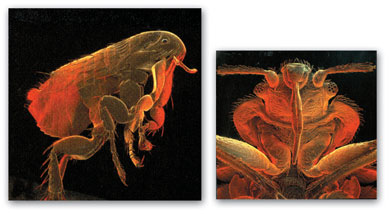 |
Mites possess perfect internal organs, legs with nerve and muscle systems, and even a brain. |
Inside the body of this creature, Allah has placed very wide-ranging, diverse and complex organs. Each has been carefully connected to the next, and systems essential to this entity's survival has been created flawlessly in its microscopic body. Could the imaginary mechanisms of evolution give rise to just one of these mites digestive or nervous system? For such an irreducibly complex system, it is of course impossible. Every detail in the tiny mite again deals a fatal blow to the theory of evolution.
Perhaps we should now be considering the following question: Should we be surprised at the bodily systems of a microorganism, at the heart that pumps blood or the brain, which consists of nerve networks, or at the single-celled creatures which lack these yet still provide the world with nutrients and oxygen, provide their own nutrients through division of labor and sometimes protects our bodies against toxins? These are all incomparable manifestations of the infinite intellect, artistry and knowledge of Allah, our Creator. As science and technology advance still further, new discoveries will be added to these, and the truth of this superior Creation will be confirmed still more, with further proofs undermining Darwinists' theories.
 |
Mites living in fields and gardens perform activities that are highly beneficial for plants. They eliminate harmful insects and assist with cleaning of the environment. |
In the Qur'an, Allah states:
Is He Who creates like him who does not create? So will you not pay heed? If you tried to number Allah's blessings, you could never count them. Allah is Ever-Forgiving, Most Merciful. (Surat an-Nahl, 17-18)
Mites Are Important Cleansers
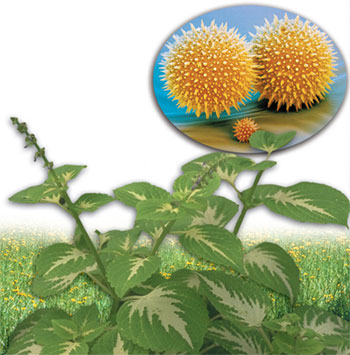 |
Mites generally undertake the cleaning of their environments. They feed on scales, secretions, fungal spores, pollen grains and plant fibers. |
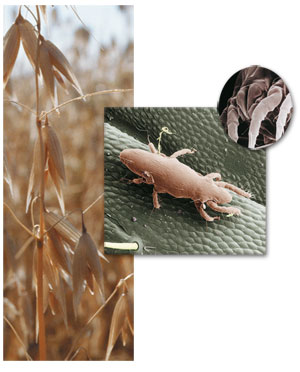 |
Pyemotes tritici, seen in the picture, generally reproduces on dried, stored cereals and grains. Thanks to mites it is impossible for insects to live on these plants. |
In the environments in which mites live, there is household dust, fabric threads, particles of human and animal skin, shed hairs, bacteria, mould spores, food particles and other organic and synthetic substances. Mites feed on these, which is why they live in such close proximity to human beings. From that perspective, you can see that a great portion of these tiny arachnids help clean up the world, eliminating the scales, secretions, dusts, fungal spores, pollen and plant fibers that constitute their diet.
The mites around us to perform this function are really very numerous. There are roughly 1,000 mites in one teaspoonful (1 gram) of house dust.107 These large numbers of mites are constantly active, engaging in highly effective cleaning. Were it not for mites, these micro-wastes would grow every day, until the Earth became uninhabitable.
Some mites benefit their surroundings still further, even though they are unaware of the fact. For example, mites of the species Pyemotes tritici generally multiply on stored cereals, dried beans and peas, in haylofts, and dried grass. They are highly useful to farmers because they paralyze and eliminate insects that feed on stored cereals and similar products.
Mites Behave Consciously
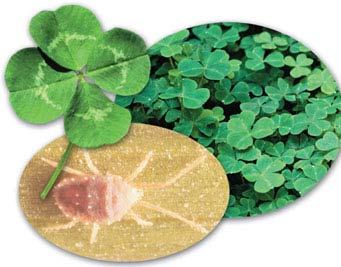 |
Clover mite |
In difficult situations, mites display methods of protecting themselves. Clover mites, for instance, enter hibernation when the winter or summer climate does not suit them. When they realize that temperatures are above or below the interval they need to live, they slow down some of their metabolic functions and go to sleep. Now in suspended animation, these living things are unaffected by the conditions around them. When the temperature returns to an favorable level, they return to their former state and resume their lives.
Some mites use their insect and arthropod hosts to transport them to different locations. Mites of the species Dinogamasus for example live in a special sac on the stomachs of certain bees and can thus easily go to the sites they wish and where they can find food.108 In order for this process to take place, such a sac must first be specially created for mites in the bee's stomach. The mites in turn must be aware of this and think of using it as a means of transport. These arthropods lack the intellect to arrive at such a mutual agreement, and under normal circumstances, they should not sense the need for any such thing.
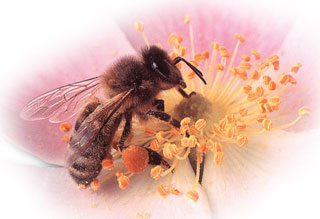 |
Mites of the species Dinogamasus live in a sac in the bee stomach. They thus find themselves a shelter, and can easily be carried where they wish to go. |
Mites are found all over the world and can multiply very rapidly. Also, there appears to be no need for a bee to undertake the difficult and tiring effort of placing mites inside itself. According to Darwinism, no living thing in fight for its own survival should be helping another species with no expectation of reward. This example therefore, shows once again, the deceptive nature of the theory of evolution. Certainly it is very difficult for evolutionists to account for how different species assist one another in this way. These creatures lack the spirit of mutual agreement and solidarity that human beings possess. This and similar examples in nature are clear proof that everything in the world has a single, superior Creator. Everything functions in the manner set out by Allah, with His permission and according to the destiny determined by Him. "There is no creature He does not hold by the forelock" (Surah Hud, 56).
In another verse, it is revealed:
That is Allah, your Lord. There is no god but Him, the Creator of everything. So worship Him. He is responsible for everything. (Surat al-An‘am, 102)
Footnotes
100- Acari General Features, Encycyopedia Britannica 2002 Interaktif Versiyon
101- http://www.ristenbatt.com/dustmite.htm – Remowing Allergens From Your Home
102- Acari Natural History, Encycyopedia Britannica 2002 Interaktif Versiyon
103- http://encarta.msn.com/find/Concise.asp?ti=02C3E000
104- Acari Natural History, Encycyopedia Britannica 2002 İnteraktif Versiyon
105- Acari Form and Function, Encycyopedia Britannica 2002 İnteraktif Versiyon
106- Acari General Features, Encycyopedia Britannica 2002 İnteraktif Versiyon
107- http://www.ristenbatt.com/dustmite.htm – Remowing Allergens From Your Home
108- Acari Natural History, Encycyopedia Britannica 2002 CD
